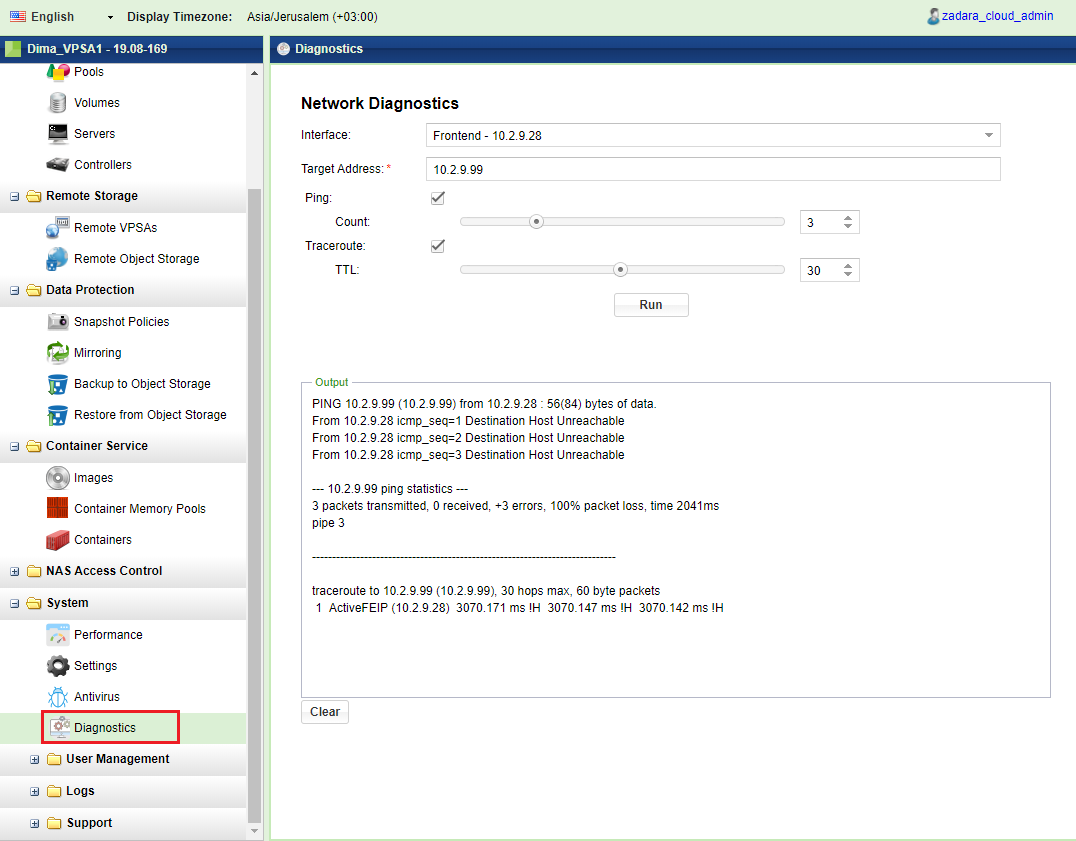Settings¶
General¶
Volumes Recycle Bin
The Recycle Bin is enabled by default, but you can also disable it. When enabled, deleted Volumes are kept in the Pool’s Recycle Bin and can be restored. If the Recycle Bin is disabled deleted Volumes are immediately destroyed and cannot be recovered.
Public IPs
This displays any Public IPs assigned to the Controllers. A Public IP allows host connectivity from outside of the VPSA VPN.
Datamover Concurrency Level
You can control the load allowed for datamovers such as mirroing, cloning, etc… by setting the concurrency level. Default is Medium
Zadara Container Services Engine
This displays which, if any, ZCS Engine has been configured via the Provisioning Portal.
Zadara IO Engine
This displays which VPSA IO Engine (Model) has been configured via the Provisioning Portal.
Security¶
Password Policy
The VPSA Admin can control the VPSA Password expiration policy and password history policy.
Dual Factor Authentication The VPSA Admin can force all users to login to the VPSA GUI using dual factor authentication. For details see: Dual Factor Authentication
Global VPSA CHAP
This gives you a uniform username and password to use when you create Servers.
Encryption
This sets the Volume encryption password for the VPSA’s data-at-rest encryption.
For more information on managing encrypted volumes see Managing Encrypted Volumes .
Support Privilege Access
This controls the ability of Zadara support engineers to access the VPSA virtual controlers with privileged rights. Only the VPSA Admin can change this setting. If enabled, the VPSA Admin gets notification every time the privileged access is used.
Cloud Admin Access
This sets the cloud admin’s VPSA GUI access (via the Command Center) to Enabled/Disabled status.
IPsec Key
This displays the key to be used when configuring IPsec tunneling for secured host connections.
NAS¶

NFS Domain
This sets the domain name for NFS shares. This defaults to localdomain. (NFS4 Only)
NFS ID mapping
If enabled, each UNIX (Linux) User must be defined as a NAS User in the VPSA. If disabled, UNIX Users are authenticated on the UNIX host side.
SMB NetBios Name
This gives the VPSA Admin the option to change the default name of the VPSA as it apears in Active Directory. This field must be modified before the VPSA joins AD.
SMB Character Set
This gives you the default Character Sets used by the SMB service for SMB/CIFS Volumes. Unix charset - indicates the local character set used by the System. DOS Charset - indicates the Character sets used to communicate with DOS(windows) clients connecting to SMB shares. If you plan to use filenames with different encoding in the filename (other than English), you may want to change the Character Set. The default value for the unix character set is UTF-8 and the default value for the DOS character set is CP850. It is important to note that some character sets can be selected using the listbox items in the setup dialog but all other character sets can be also specified by directly editing the settings field.

Changing this value while clients are connected will cause them to temporarily lose access to all SMB shares.
Defragmentation
You can enable/disable background file system defragmentation. This also allows on-demand defragmentation.
File System Trim
This
Periodic fstrim is triggered every weekend (On Saturday 00:00)
Can be manually started and stopped via the settings page.
Metering¶
The VPSA provides an option to download its performance metering database which contains per-minute performance statistics about all active and monitored Objects – Drives, RAID Groups, Pools, Volumes and Servers. The database is downloaded in a binary format and is accompanied with a tool (meter2csv) to convert the raw binary database to a csv formatted file.
Container Service¶
Container Network
This displays the internal IP range of the ZCS and is accessible only by the host VPSA.
Exposed Ports
This displays the Ports ranges that are exposed for host access.
Image Repository
This displays the Status, Pool and Capacity of the Image Repository that stores all of the ZCS containers and images.
Network¶
VPSA support Jumbo Frames. MTU size can be set to values from 1500 to 9000 for both the Front End (data) network, and the public network & VNIs (Public & VNI network MTU). Default is 1500 for both.
Note
Changing the MTU can be disruptive for ongoing traffic. Existing iSCSI server sessions may require a restart for the new MTU setting to take effect.
Diagnostics¶
Network Diagnostics¶
A common issue storage administrators pace is the ability to verify connectivity between the storage system and the servers using the storage. Connectivity might be even harder to verify in a cloud environment, depending on the network topology. VPSA Network Diagnostic allows you to check connectivity over the selected network to any server:
Go to the page.
Select the VPSA network interface
Enter the target IP address of the server in question.
select if you want to ping the server, traceroute or both
Click .
It take a minute or so until the results show up in the output box.




